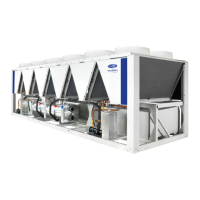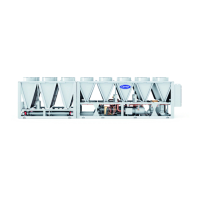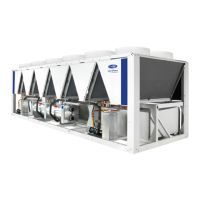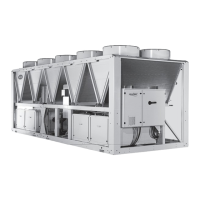2
SAFETY CONSIDERATIONS
Installing, starting up, and servicing this equipment can be haz-
ardous due to system pressures, electrical components, and
equipment location (roof, elevated structures, etc.). Only trained,
qualified installers and service technicians should install, start
up, and service this equipment. When working on this equip-
ment, observe precautions in the literature, on tags, stickers, and
labels attached to the equipment, and any other safety precau-
tions that apply. Follow all safety codes. Wear safety glasses and
work gloves. Use care in handling, rigging, and setting this
equipment, and in handling all electrical components.
WARNING
Electrical shock can cause personal injury and death. Shut
off all power to this equipment during installation and ser-
vice. There may be more than one disconnect switch. Tag
all disconnect locations to alert others not to restore power
until work is completed.
WARNING
Electrical shock can cause personal injury and death. After
unit power is disconnected, wait at least 20 minutes (if
compressor VFDs [variable frequency drives] are mounted
external to control panel) or 40 minutes (if compressor
VFDs are mounted internal to control panel) for the VFD
capacitors to discharge before opening drive.
WARNING
DO NOT VENT refrigerant relief valves within a building.
Outlet from relief valves must be vented in accordance with
the latest edition of ANSI/ASHRAE (American National
Standards Institute/American Society of Heating, Refriger-
ating and Air-Conditioning Engineers) 15 (Safety Code for
Mechanical Refrigeration). The accumulation of refrigerant
in an enclosed space can displace oxygen and cause as-
phyxiation. Provide adequate ventilation in enclosed or low
overhead areas. Inhalation of high concentrations of vapor
is harmful and may cause heart irregularities, unconscious-
ness or death. Misuse can be fatal. Vapor is heavier than air
and reduces the amount of oxygen available for breathing.
Product causes eye and skin irritation. Decomposition
products are hazardous.
WARNING
DO NOT USE TORCH to remove any component. System
contains oil and refrigerant under pressure.
To remove a component, wear protective gloves and gog-
gles and proceed as follows:
a. Shut off electrical power to unit.
b. Recover refrigerant to relieve all pressure from system
using both high-pressure and low pressure ports.
c. Traces of vapor should be displaced with nitrogen and the
work area should be well ventilated. Refrigerant in contact
with an open flame produces toxic gases.
d. Cut component connection tubing with tubing cutter and
remove component from unit. Use a pan to catch any oil
that may come out of the lines and as a gage for how
much oil to add to the system.
e. Carefully unsweat remaining tubing stubs when neces-
sary. Oil can ignite when exposed to torch flame.
Failure to follow these procedures may result in personal
injury or death.
CAUTION
Standard Tier units (units with S in the 10th position of the
model number) without VFDs (units with “-”, “1”, “3”, or
“5” in the 13th position of the model number) must have
the condenser fan(s) rotation verified to ensure proper phas-
ing. Correct rotation is counter-clockwise (reference arrow
on fan hub). Swap any two incoming power leads to correct
condenser fan rotation before starting chiller. Operating the
unit without testing the condenser fan(s) for proper phasing
could result in equipment damage.
CAUTION
DO NOT re-use compressor oil or any oil that has been ex-
posed to the atmosphere. Dispose of oil per local codes and
regulations. DO NOT leave refrigerant system open to air
any longer than the actual time required to service the equip-
ment. Seal circuits being serviced and charge with dry nitro-
gen to prevent oil contamination when timely repairs cannot
be completed. Failure to follow these procedures may result
in damage to equipment.
CAUTION
This unit uses a microprocessor control system. Do not
short or jumper between terminations on circuit boards or
modules; control or board failure may result.
Be aware of electrostatic discharge (static electricity) when
handling or making contact with circuit boards or module
connections. Always touch a chassis (grounded) part to dis-
sipate body electrostatic charge before working inside con-
trol center.
Use extreme care when handling tools near boards and
when connecting or disconnecting terminal plugs. Circuit
boards can easily be damaged. Always hold boards by the
edges and avoid touching components and connections.
This equipment uses, and can radiate, radio frequency ener-
gy. If not installed and used in accordance with the instruc-
tion manual, it may cause interference to radio communica-
tions. It has been tested and found to comply with the limits
for a Class A computing device pursuant to International
Standard in North America EN 61000-2/3 which are de-
signed to provide reasonable protection against such inter-
ference when operated in a commercial environment. Oper-
ation of this equipment in a residential area is likely to
cause interference, in which case the user, at his own ex-
pense, will be required to take whatever measures may be
required to correct the interference.
Always store and transport replacement or defective boards
in anti-static shipping bag.
CAUTION
To prevent potential damage to heat exchanger tubes, always
run fluid through heat exchanger when adding or removing re-
frigerant charge. Use appropriate antifreeze solutions in evapo-
rator fluid loop to prevent the freezing of heat exchanger or in-
terconnecting piping when the equipment is exposed to tem-
peratures below 32°F (0°C). Proof of flow switch is factory
installed on all models. Do NOT remove power from this
chiller during winter shut down periods without taking precau-
tion to remove all water from heat exchanger. Failure to prop-
erly protect the system from freezing may constitute abuse and
may void warranty.
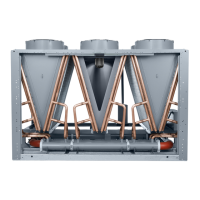
